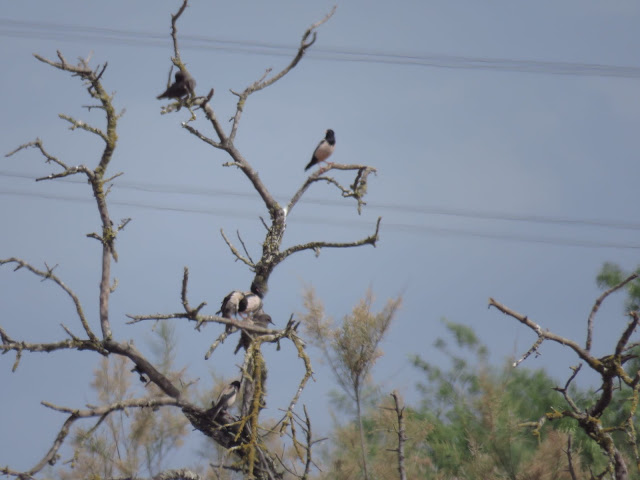Una altra cotxa fumada aberrant a Catalunya / Another aberrant Black Redstart in Catalunya
El 26 de febrer de 2018 es va veure un ocell blanquinós que va ser identificat ràpidament com una cotxa fumada aberrant. L’ocell va ser vist a Vilabella, Alt Camp (Kiku Parés). Als voltants del migdia, es van poder obtenir tres fotos prop el Mas de Ramonet, coordenades 360614,4565240 (UTM ETRS89).
L’ocell era essencialment blanquinós, potser amb un toc marronós i amb un ull de color normal, fosc. El cap presentava tons grisos i la cua era de tons vermellosos pàl·lids. El plomatge no semblava gastat, d’acord amb l’estat de la punta de les plomes segons es veu a les fotos. Un panell alar blanc i el to més fosc del cap suggereixen que la cotxa era mascle.
Aquest seria un cas d’una cotxa més pàl·lida que la detectada al delta del Llobregat el gener de 2018.
Com que tant les àrees grises com vermelloses són molt diluïdes en aquest exemplar, les dues melanines responsable d’aquestes coloracions són absents o en nivells baixos (l’eumelanina pels tons grisos i negres i la faeomelanina pels vermellosos). La faeomelanina seria una mica més abundant que l’eumelanina vist el to vermellós de la cua de l’ocell.
L’ocell no seria un albí perquè té una mica de pigmentació, incloent-hi la de les parts no plomades. Una aberració ‘brown’ tampoc fora el cas vist que l’ocell té reducció dels dos pigments i l’aberració ‘brown’ implica només la reducció de l’eumelanina (o sigui, que la cotxa tindria el to de la cua sense variar, cosa que no és el cas). Una aberració de dilució, que implicaria una afectació als dos pigments sembla el cas més probable, si bé d’acord amb van Grouw (2006) la variació pastel (la del Llobregat de gener) afecta aproximadament el 50% de la melanina (i aquí l’ocell és gairebé blanc). Un ‘ino’ també resta descartat perquè la reducció de pigments és en els dos i perquè això implicaria que l’ocell presentés uns ulls vermells cosa que no passa. Per tant, l’ocell sigui probablement un ‘pastel’ amb una gran reducció de l’eumelanina i una menor reducció de la faeomelanina ja que li resten algunes àrees grises al cap.
On 26 february 2018 a whitish bird quickly identified as an aberrant Black Redstart (Phoenicurus ochruros) was seen and photographed at Vilabella, Alt Camp (Kiku Parés). About noon, three photos of the bird were obtained near Mas de Ramonet, at 360614,4565240 (UTM ETRS89).
The bird was overall whitish, perhaps with a brownish tinge and with normally coloured eye. The head, though, presented a pale grey tinge while the tail was pale reddish. The plumage appeared not worn, according to the shape of wing tips as shown in the photos. The white wing patch and darker tone in the head suggests it was a male.
This is a paler bird than the ‘pastel’ seen in the Llobregat delta in January 2018 .
Since both dark grey and red are very diluted in this bird, both melanins responsable of these colours (eumelanin, grey and Black; phaeomelanin, reddish tones) are almost lacking or in low levels. Phaeomelanin would be a bit more abundant compared to eumelanin given the reddish subtle tinge in the bird’s tail.
The bird is not an albino since it has some pigmentation, including bare parts. A brown aberration would not be the case because the bird has a reduction in both pigments and brown aberration implies only an eumelanin reduction (e.g. the bird would keep the regular tail colour, which is not the case). A dilution aberration, that would imply an impact on both pigments could be the case but according to van Grouw (2006) the pastel variation (that of the Llobregat bird from January) affects c.50% of the melanin (and here the bird is almost white). An Ino is also discarded since the reduction in both pigments also imply a lack in eye pigments which become reddish, unlike this bird. The bird is probably a pastel bird with a large reduction on eumelanin and a lesser reduction on phaeomelanin given it keeps some pale grey areas in the head.
References
van Grouw, H (2006) Not every white bird is an albino: sense and nonsense about colour aberrations in birds. Dutch Birding 28: 79-89




